Hanmi-handachi
SHIHO-NAGE
Demonstrated and explained by Kanetsuka Sensei
|
|

Photos and text: Peter Megann
Graphics and typesetting: Graham and Laura Jones
Uke: Richard Martin
|
Hanmi-handachi shiho-nage techniques are important not simply as throwing techniques but as training in how to sit (seiza), how to move with correct shikko, how to shift the centre of gravity from front to rear, how to turn the body through 180°. how to stand up without wobbling (as in the ryote-dori version).

1. Katate-dori
Photo 1: The situation: Tori is sitting in seiza with his hands placed on his knees. Uke. moving off the attacking line, seizes Tori's left wrist with the intention of pulling Tori towards him and striking or kicking him. Responding to Uke's pull Tori rises onto his toes into kiza so that the contact point between Uke and Tori goes down so that even if Uke is holding strongly his force is deflected: he loses control of Tori and he is brought off balance. As Tori lifts his left elbow there is a feeling of slashing Uke's lower leg. There must be no pushing here.
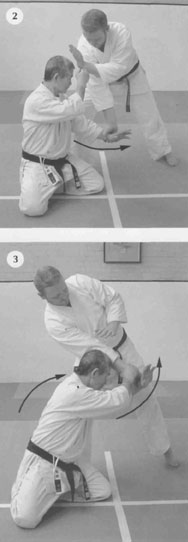 Photo 2: Responding to Uke's pull. Tori pivots on his right knee and slides his left knee slightly forward (not further than Uke's centre), his right toes following his left toes {shikko). (Tori's posture is now exactly the same as in Photo 1 except that he is sitting in kiza rather than in seiza, and his weight is coming up and forward. Essentially it is his centre which is moving.) (Do not move too far forwards: the knees are almost the same distance apart as in the starting position.) Tori now makes atemi with his right hand as he raises his left hand from his knee. His left hand is open and turned up. the thumb turning inwards. His left elbow is turned slightly outwards so that the shape is like that in suwari-waza kokyu-ho exercise. Note how Tori's movement has brought his front knee forwards to bring him into a triangular position relevant to the original forward line. In other words he is now in what is essentially hidari-hanmi.
Photo 2: Responding to Uke's pull. Tori pivots on his right knee and slides his left knee slightly forward (not further than Uke's centre), his right toes following his left toes {shikko). (Tori's posture is now exactly the same as in Photo 1 except that he is sitting in kiza rather than in seiza, and his weight is coming up and forward. Essentially it is his centre which is moving.) (Do not move too far forwards: the knees are almost the same distance apart as in the starting position.) Tori now makes atemi with his right hand as he raises his left hand from his knee. His left hand is open and turned up. the thumb turning inwards. His left elbow is turned slightly outwards so that the shape is like that in suwari-waza kokyu-ho exercise. Note how Tori's movement has brought his front knee forwards to bring him into a triangular position relevant to the original forward line. In other words he is now in what is essentially hidari-hanmi.
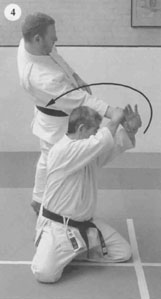 Photos 3 & 4: Without pushing, pulling or lifting (the feeling is more like the left hand floating) - it's a matter of leading Uke: Tori and Uke must be 100% in harmony - Tori takes Uke's right wrist with his right hand and swings his left hand upwards as his left elbow expands. At the same time he inclines his body forwards so that his head approaches his hands. This movement is just as in making a sitting bow but in a vertical plain. The centre or contact point of this arm movement is first the left wrist joint, then the elbow joint and finally the shoulder joint, which moves like a hinge. His two wrists are crossing at this point. As Tori cuts up so that his hands cover his head (furi-kaburi), his elbows expanding, he starts to transfer his weight from his left knee to his right toes with a rocking movement. Note how Uke is brought up onto his toes and his body is turning away from Tori. He finishes behind Tori. You must cur up in a straight vertical line and not be in a hurry to turn.
Photos 3 & 4: Without pushing, pulling or lifting (the feeling is more like the left hand floating) - it's a matter of leading Uke: Tori and Uke must be 100% in harmony - Tori takes Uke's right wrist with his right hand and swings his left hand upwards as his left elbow expands. At the same time he inclines his body forwards so that his head approaches his hands. This movement is just as in making a sitting bow but in a vertical plain. The centre or contact point of this arm movement is first the left wrist joint, then the elbow joint and finally the shoulder joint, which moves like a hinge. His two wrists are crossing at this point. As Tori cuts up so that his hands cover his head (furi-kaburi), his elbows expanding, he starts to transfer his weight from his left knee to his right toes with a rocking movement. Note how Uke is brought up onto his toes and his body is turning away from Tori. He finishes behind Tori. You must cur up in a straight vertical line and not be in a hurry to turn.
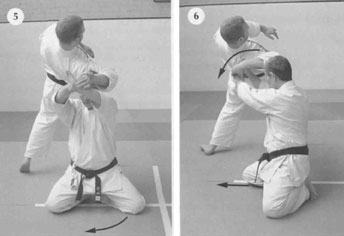 Photo 5 & 6: Tori turns his body through 180°. changing from hidari-hanmi to migi-hanmi. The relationship between Tori and Uke in Photo 5 is the same as in haishin-undo (back-stretch exercise). Tori's left knee moves slightly forward in Photo 5. Note that Tori keeps Uke's hand in front of his forehead during this turn. As Tori finishes this turn the gripping action of his right hand on Uke's wrist is like that of sankyo, twisting or wringing just as when you apply sankyo to your own wrist in warm-up exercises. His right hand is touching Uke's shoulder-blade while his left hand is pointing towards Uke's neck. As he completes the turn (Photo 6). Tori is cutting downwards (not outwards). If this operation is done correctly Uke simply falls to the ground without any need for Tori to throw. Uke steps back and makes ushiro-ukemi.
Photo 5 & 6: Tori turns his body through 180°. changing from hidari-hanmi to migi-hanmi. The relationship between Tori and Uke in Photo 5 is the same as in haishin-undo (back-stretch exercise). Tori's left knee moves slightly forward in Photo 5. Note that Tori keeps Uke's hand in front of his forehead during this turn. As Tori finishes this turn the gripping action of his right hand on Uke's wrist is like that of sankyo, twisting or wringing just as when you apply sankyo to your own wrist in warm-up exercises. His right hand is touching Uke's shoulder-blade while his left hand is pointing towards Uke's neck. As he completes the turn (Photo 6). Tori is cutting downwards (not outwards). If this operation is done correctly Uke simply falls to the ground without any need for Tori to throw. Uke steps back and makes ushiro-ukemi.
2. Ryote-dori
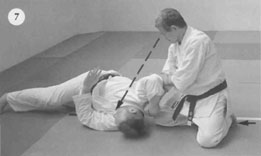 Photo 7: Tori follows Uke's fall and sticks closely to him to pin him, his right hand coming down to his right knee. Keeping your feet together slide your knee forwards and finish in kiza with zan-shin.
Photo 7: Tori follows Uke's fall and sticks closely to him to pin him, his right hand coming down to his right knee. Keeping your feet together slide your knee forwards and finish in kiza with zan-shin.
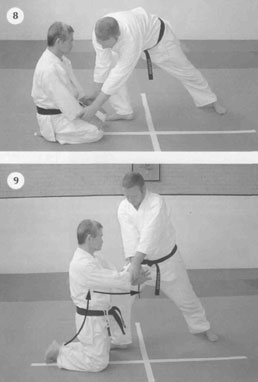 Photos 8 & 9: When Uke grips both his wrists and pulls him forwards. Tori rises onto his toes and follows Uke. extending his arms, opening his hands and keeping his back straight.
Photos 8 & 9: When Uke grips both his wrists and pulls him forwards. Tori rises onto his toes and follows Uke. extending his arms, opening his hands and keeping his back straight.
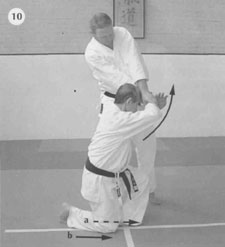 Photo 10: Tori steps forward positively with his left foot (a) while taking Uke's right wrist with his right hand, his left hand pointing upwards as he turns his wrist inwards with a screwing action. Tori brings his hands up in front of his forehead and inclines his head towards them, as in Photo 3. His right knee moves up to his left heel (b) with the principle of tsugi-ashi (do not leave your left knee behind or else you will have difficulty standing up smoothly), and his rear foot finishes on a straight line behind his forward foot; i.e. his lower leg does not finish at right angles to the line of his advance. As Tori's centre moves forward and his arms cut up Uke is brought up onto his toes and above Tori.
Photo 10: Tori steps forward positively with his left foot (a) while taking Uke's right wrist with his right hand, his left hand pointing upwards as he turns his wrist inwards with a screwing action. Tori brings his hands up in front of his forehead and inclines his head towards them, as in Photo 3. His right knee moves up to his left heel (b) with the principle of tsugi-ashi (do not leave your left knee behind or else you will have difficulty standing up smoothly), and his rear foot finishes on a straight line behind his forward foot; i.e. his lower leg does not finish at right angles to the line of his advance. As Tori's centre moves forward and his arms cut up Uke is brought up onto his toes and above Tori.
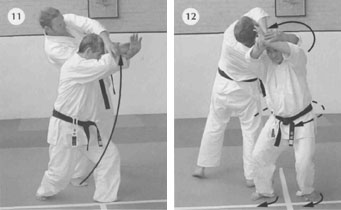 Photo 11: Tori stands straight up. The crown of his head is now the centre of the movement. His weight is on his forward foot.
Photo 11: Tori stands straight up. The crown of his head is now the centre of the movement. His weight is on his forward foot.
Photo 12: Keeping Uke's hands in front of his forehead Tori turns through 180° to his right, pivoting on the balls of his feet (first on the left foot and then on the right) and maintaining a low posture.
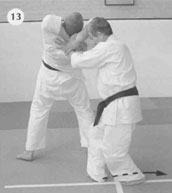
 Photos 13 & 14: At the same time as Tori starts to lower his hands he steps back with his right foot. The reason why Tori steps back at this point is in order to maintain good balance and ma-ai. If he does not take a step back, the movement becomes very tight. The action from Photo 10 to Photo 15 must be continuous and flowing.
Photos 13 & 14: At the same time as Tori starts to lower his hands he steps back with his right foot. The reason why Tori steps back at this point is in order to maintain good balance and ma-ai. If he does not take a step back, the movement becomes very tight. The action from Photo 10 to Photo 15 must be continuous and flowing.
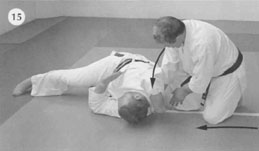 Photo 15: As Uke falls Tori steps forwards with his right foot, advancing his whole body, and follows him to the tatami. Of course. Tori can finish in a standing hanmi position (as Uke's posture in Photo 1).
Photo 15: As Uke falls Tori steps forwards with his right foot, advancing his whole body, and follows him to the tatami. Of course. Tori can finish in a standing hanmi position (as Uke's posture in Photo 1).
The most important point in this technique is to keep your partner under control from beginning to end: how to move naturally with your partner, harmonizing your movement with his.


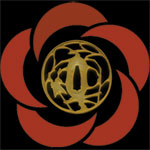
 Photo 2: Responding to
Photo 2: Responding to  Photos 3 & 4: Without pushing, pulling or lifting (the feeling is more like the left hand floating) - it's a matter of leading
Photos 3 & 4: Without pushing, pulling or lifting (the feeling is more like the left hand floating) - it's a matter of leading  Photo 5 & 6:
Photo 5 & 6:  Photo 7:
Photo 7:  Photos 8 & 9: When
Photos 8 & 9: When  Photo 10:
Photo 10:  Photo 11:
Photo 11: 
 Photos 13 & 14: At the same time as
Photos 13 & 14: At the same time as  Photo 15: As
Photo 15: As